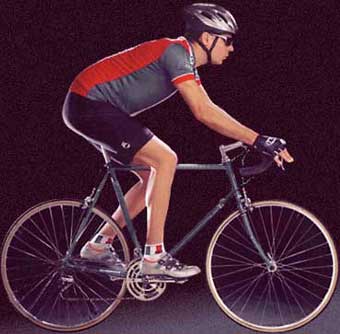Here's How To Find A Fine Bicycle Fit
Whether you ride on road or off, pedal casually or competitively; bicycling is most comfortable and efficient when your bike and components are adjusted to fit your body correctly. We take care to ensure that your new bike is fit to you optimally. As you develop as a cyclist, maintain your equipment and travel with your bicycle, however, your adjustments and needs may change and require fine-tuning.
To help, we've put together these guidelines for checking and perfecting your fit. They work for on- and off-road bikes (assuming you're on the right-size bicycle and not trying to fit a too-small or large model you purchased at a yard sale, for example). Keep in mind that we specialize in bike fit. If you're experiencing a problem that you can't fix at home, come in and see us. A proper fit is comfortable and efficient.
A proper fit is comfortable and efficient.
Click on the images below for complete details on each fitting step.
 A proper fit is comfortable and efficient.
A proper fit is comfortable and efficient.Click on the images below for complete details on each fitting step.
Notes
As with the other adjustments, this is a safe starting position.
If you're over 6-feet tall, ride long distances, climb a lot and pedal at about 90 rpm, you may prefer to be as much as 1 to 2 cm behind the pedal axles.
If you're less than 6-feet tall, spin at 95 rpm or faster and like to sprint, you'll probably prefer to be directly over the axles.">
Notes
As with the other adjustments, this is a safe starting position.
If you're over 6-feet tall, ride long distances, climb a lot and pedal at about 90 rpm, you may prefer to be as much as 1 to 2 cm behind the pedal axles.
If you're less than 6-feet tall, spin at 95 rpm or faster and like to sprint, you'll probably prefer to be directly over the axles." data-width="156px" data-height="212px" data-thumbnail="/images/library/site/bike_fit1foreaft.jpg">
It's usually not a good idea to raise the handlebars too much. Once they're higher than the seat, your body weight is shifted more over the rear of the bike, which can mean greater jolts from bumps in the road. This can lead to discomfort and pain.">
It's usually not a good idea to raise the handlebars too much. Once they're higher than the seat, your body weight is shifted more over the rear of the bike, which can mean greater jolts from bumps in the road. This can lead to discomfort and pain." data-width="348px" data-height="134px" data-thumbnail="/images/library/site/bike_fit1stemheight.jpg">
